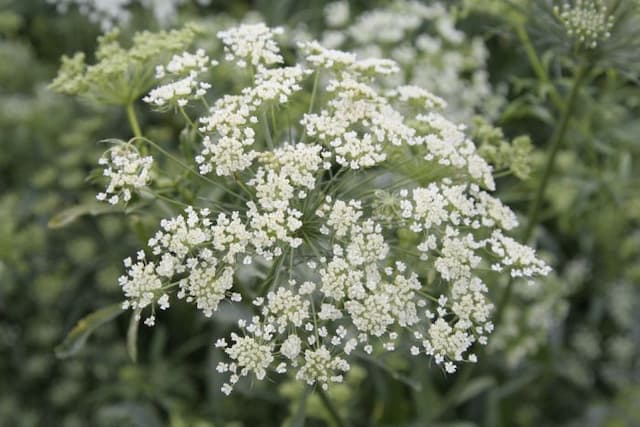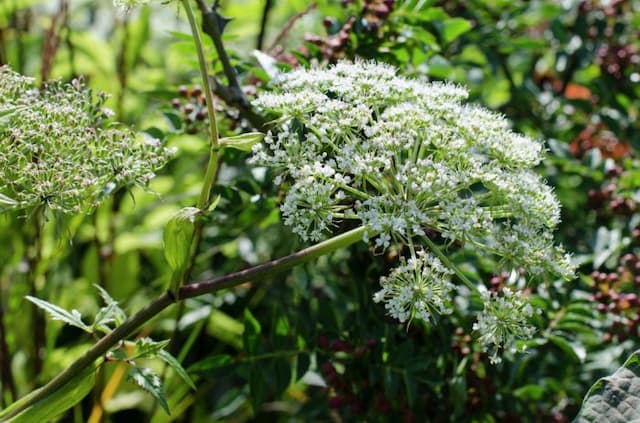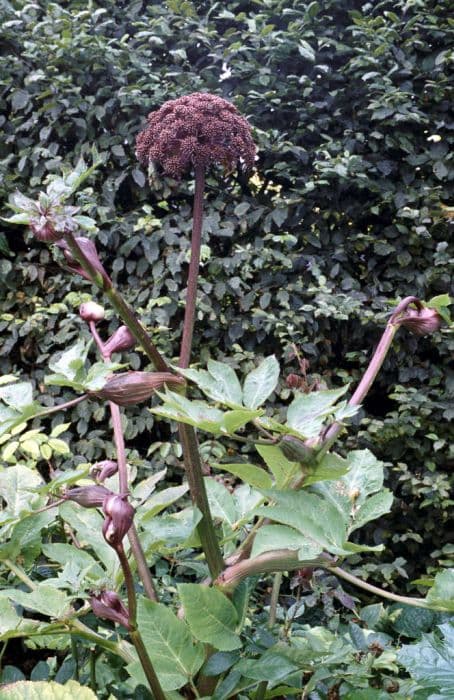Sea Holly Eryngium 'Blue Jackpot'

ABOUT
Eryngium 'Blue Jackpot', commonly known as sea holly, is a striking perennial plant with a distinctive appearance. This variety features a rosette of spiky, variegated leaves that are often edged with a creamy white margin. The texture of the leaves is coarse, and their color can range from green with variegation to a bluish hue, adding to the plant's visual interest. The most captivating feature of Blue Jackpot is its flower heads. These are globular, thistle-like blooms that stand above the foliage on stiff, branched stems. The flowers can be described as metallic or electric blue, creating a dramatic display with a cone-like shape, surrounded by spiny bracts. These bracts, which can also have blue tinges, further accentuate the flower heads, making them stand out in garden settings. The blooms not only provide visual appeal but are also attractive to butterflies and other pollinators, adding life to the garden. As a sea holly, Eryngium 'Blue Jackpot' boasts a rugged and resilient nature, often found with gray-green stems that form a stark contrast against the bold blue flowers and variegated foliage. This combination of features contributes to its popularity for use in ornamental gardens, borders, and as cut flowers in floral arrangements, where its unique texture and color can be thoroughly appreciated.
About this plant
 Names
NamesFamily
Apiaceae
Synonyms
Blue Jackpot Sea Holly, Blue Jackpot Eryngo
Common names
Sorry, but there is no available synonym for Eryngium 'Blue Jackpot'; the provided name is its basic cultivar name.
 Toxicity
ToxicityTo humans
Sea holly is not known to be toxic to humans. Therefore, ingesting parts of the Sea holly, including 'Blue Jackpot', is unlikely to cause poisoning or serious health issues. However, it is generally not recommended to consume ornamental plants due to the potential for pesticides and other chemicals on the plant, and individual allergic reactions could occur.
To pets
Sea holly is not known to be toxic to pets. Ingesting parts of the Sea holly, such as 'Blue Jackpot', should not result in poisoning or severe health consequences for pets. However, as with any plant not intended for pet consumption, it is possible for pets to experience mild gastrointestinal upset if they eat large quantities of the plant or if they have a specific sensitivity to it.
 Characteristics
CharacteristicsLife cycle
Perennials
Foliage type
Evergreen
Color of leaves
Green
Flower color
Blue
Height
2 feet [61 cm]
Spread
1 foot [30 cm]
Plant type
Herb
Hardiness zones
5
Native area
Mediterranean
Benefits
 General Benefits
General Benefits- Drought Tolerant: Once established, the Sea Holly 'Blue Jackpot' can tolerate periods of drought, making it suitable for xeriscaping and low-water gardens.
- Attracts Pollinators: The vibrant flowers attract bees, butterflies, and other beneficial insects, which are essential for pollination.
- Deer and Rabbit Resistant: The spiny texture and unique taste of the foliage make it less appealing to deer and rabbits, reducing garden browsing damage.
- Unique Floral Display: The striking blue-violet flowers add visual interest and a splash of color to borders, beds, and floral arrangements.
- Low Maintenance: Sea Holly 'Blue Jackpot' requires minimal care once established, thriving in poor soils with little supplemental fertilizing or pruning.
- Long Blooming Period: The plant has a long flowering season, typically blooming from midsummer through early fall, providing a long-lasting display.
- Structural Interest: The rigid, thistle-like appearance adds texture and architectural interest to garden landscapes and dried flower arrangements.
- Coastal Garden Suitable: Due to its tolerance of salty air and winds, it is an excellent choice for coastal gardens.
 Medical Properties
Medical PropertiesThis plant is not used for medical purposes.
 Air-purifying Qualities
Air-purifying QualitiesThis plant is not specifically known for air purifying qualities.
 Other Uses
Other Uses- Eryngium 'Blue Jackpot', commonly known as Sea Holly, can be used as a natural dye for fabrics due to its intense blue color, providing a unique hue to textiles.
- Sea Holly is often included in floral arts and dried flower arrangements; when dried, the flowers retain their color and shape, making them ideal for long-lasting displays.
- Due to its spiky texture and unique form, Sea Holly can be used in garden designs to deter animals and pets from entering certain areas.
- The plant is sometimes utilized in themed garden spaces, such as medieval or xeriscaping gardens, due to its historic appeal and drought tolerance.
- Sea Holly can function as an educational tool in botanic gardens and nature programs, highlighting plant survival strategies in harsh environments.
- Its striking appearance makes Sea Holly a popular choice for photography projects, especially macro and close-up nature photography.
- Culinary experimentation with Sea Holly involves using its young shoots in salads, where they can add a crisp texture and hint of artichoke-like flavor.
- Sea Holly can be planted along coastlines to help reduce soil erosion with its deep root system that stabilizes the ground.
- The plant can be used in floral fashion accessories, such as boutonnieres or corsages, particularly for events with a natural or rustic theme.
- Insect enthusiasts may use Sea Holly to attract and observe a variety of pollinators such as bees, butterflies, and other insects that are drawn to the plant's vivid flowers.
Interesting Facts
 Feng Shui
Feng ShuiThe plant Sea Holly is not used in Feng Shui practice.
 Zodiac Sign Compitability
Zodiac Sign CompitabilityThe plant Sea Holly is not used in astrology practice.
 Plant Symbolism
Plant Symbolism- Determination: Eryngium, commonly known as sea holly, often symbolizes determination because of its hardy nature and ability to thrive in difficult conditions.
- Independence: Its thistle-like appearance conveys a sense of independence and a can-do spirit, often flourishing where other plants may not.
- Attraction: Historically, sea holly has been thought to possess aphrodisiac properties, leading to its association with attraction and allure.
- Protection: The prickly texture of sea holly gives it an association with protection, as it can seem like a natural defense against negative forces.
 Water
WaterThe Sea Holly or Eryngium 'Blue Jackpot' should be watered deeply but infrequently to mimic its natural dry habitat conditions. It is best to water this perennial when the top inch of soil feels dry to the touch, which could be about once a week during the peak of summer. When watering, aim for about one to two gallons per plant, ensuring water penetrates deeply into the soil to encourage deep root growth. During the cooler months, water less frequently, allowing the soil to dry out more between watering sessions. Adjust watering habits according to weather conditions, watering more during hot, dry spells and less during periods of rain or cooler temperatures.
 Light
LightSea Holly thrives in full sun conditions, where it can receive at least six hours of direct sunlight daily. The ideal spot for Eryngium 'Blue Jackpot' would be in a location that provides bright and unfiltered light throughout the day. This plant does well in southern or western exposures where the sun is most intense.
 Temperature
TemperatureSea Holly prefers temperatures that range between 60 and 80 degrees Fahrenheit, thriving in most temperate regions. While it can survive minimum temperatures down to about 0 degrees Fahrenheit, it is important to provide protection in colder climates. The ideal conditions for Eryngium 'Blue Jackpot' are those that avoid extreme heat above 90 degrees Fahrenheit, as too much heat can stress the plant.
 Pruning
PruningPruning Sea Holly is generally done to remove spent flowers and encourage new growth. Eryngium 'Blue Jackpot' should be pruned back in late fall or early spring before new growth begins. Deadheading, or the removal of old flowers, can occur throughout the blooming season to improve appearance and potentially encourage additional blooming. However, some gardeners prefer to leave the unique seed heads for winter interest and to provide food for birds.
 Cleaning
CleaningAs needed
 Soil
SoilThe best soil mix for Sea Holly (Eryngium 'Blue Jackpot') should be well-draining, with a mixture of garden soil, compost, and gritty material like sand or perlite to improve drainage. Sea Holly prefers slightly alkaline to neutral pH levels, around 6.5 to 7.5.
 Repotting
RepottingSea Holly (Eryngium 'Blue Jackpot') does not require frequent repotting and can typically be repotted every 2-3 years. However, it might be necessary to repot if you notice signs of the plant outgrowing its current container or if the soil has degraded significantly.
 Humidity & Misting
Humidity & MistingSea Holly (Eryngium 'Blue Jackpot') is tolerant of a range of humidity conditions and does well in average household humidity. It does not require any special humidity adjustments.
 Suitable locations
Suitable locationsIndoor
Place Sea Holly in bright light; water sparingly.
Outdoor
Full sun, well-draining soil; tolerate drought.
Hardiness zone
Zones 5-9 USDA.
 Life cycle
Life cycleThe life cycle of Eryngium 'Blue Jackpot', commonly known as Sea Holly, begins with seed germination, which is usually prompted by a period of cold stratification to break dormancy. Once the seedlings emerge and establish, they transition into a vegetative state characterized by the growth of spikey silver-blue foliage that forms a rosette pattern. As the plant matures, it enters the flowering stage, typically in summer, where it produces distinctive steel-blue flowers atop branched stems, which are attractive to pollinators like bees and butterflies. After pollination, Sea Holly will set seed, completing the reproductive phase of its life cycle as the flowers fade and seed heads develop. The plant may remain dormant over winter, particularly in colder climates, by dying back to the ground and then regrowing from its perennial rootstock when conditions are favorable. Sea Holly can also spread by rhizome formation, gradually expanding its clump size and presence in the garden over successive seasons.
 Propogation
PropogationPropogation time
Early Summer
Eryngium 'Blue Jackpot', commonly known as Sea Holly, is best propagated by seed. To ensure successful germination, seeds should be sown in late winter or early spring. Start by placing the seeds on a moist seed-starting mix, lightly covering them with soil, and maintaining a temperature of around 70 degrees Fahrenheit (21 degrees Celsius). It usually takes about two to four weeks for the seeds to germinate. Once the seedlings have grown sufficiently and the danger of frost has passed, they can be transplanted outdoors to a sunny location with well-draining soil.









